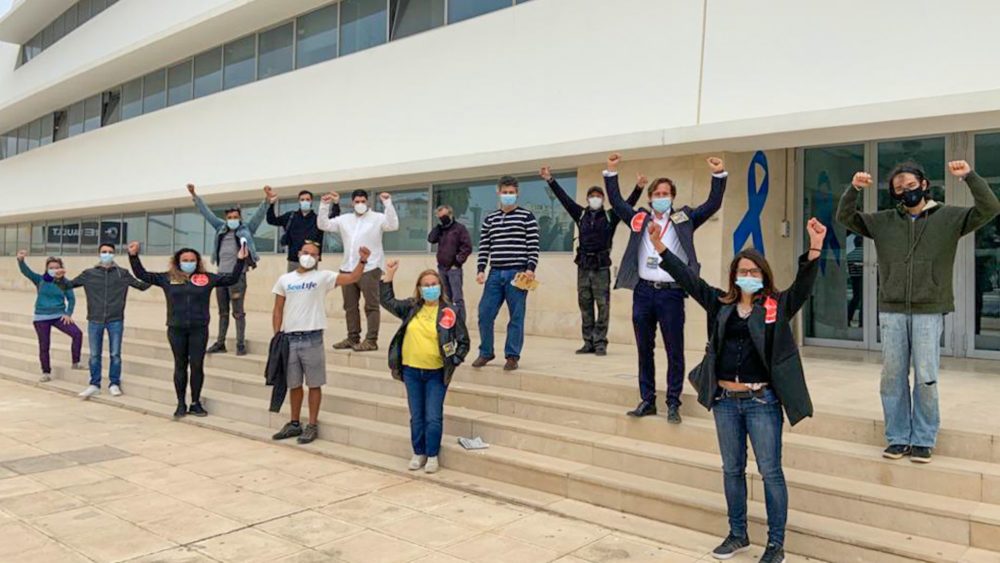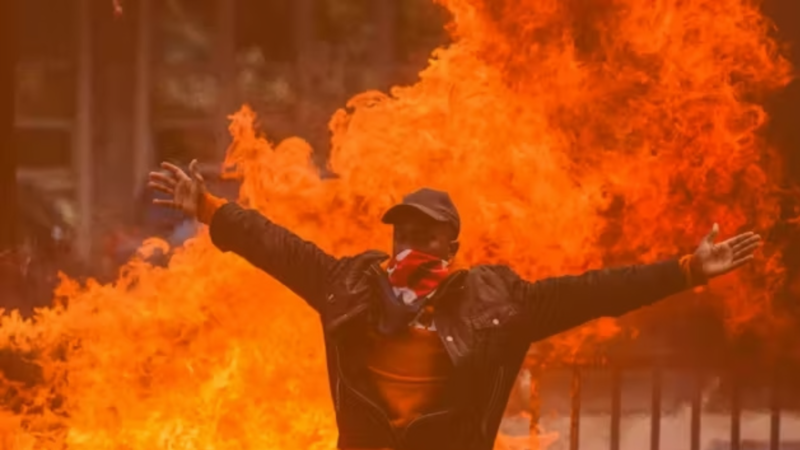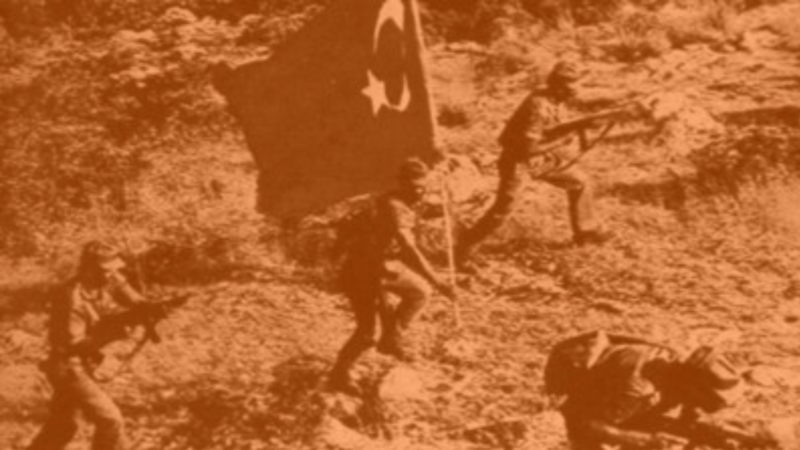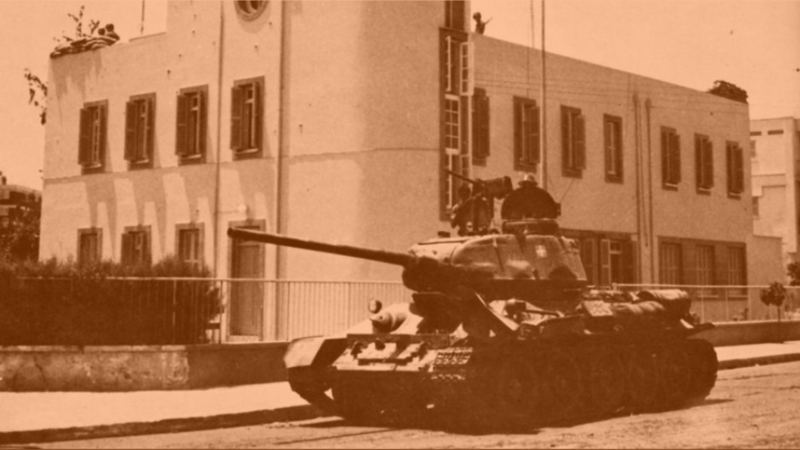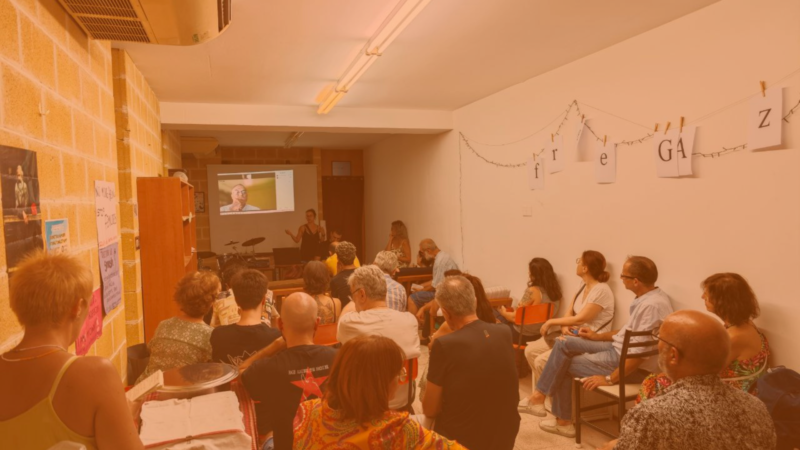These days, progressive grassroots activism isn’t doing much winning.
But a recent citizen-led campaign to save a piece of Portugal’s natural beauty from private development reached roughly half its goals, after running for only four weeks. And now, it’s well-positioned to continue to pursue the rest of its demands.
This campaign was part of the Campaign Accelerator programme, an incubator for grassroots actions that we developed at DiEM25. I worked on the Portugal project with the Campaign Accelerator team, and in this post I’ll look at what we did — from evaluating the idea to evaluating the project’s results — and what we learned.
1. The issue: the cliffs of Ponta Da Piedade
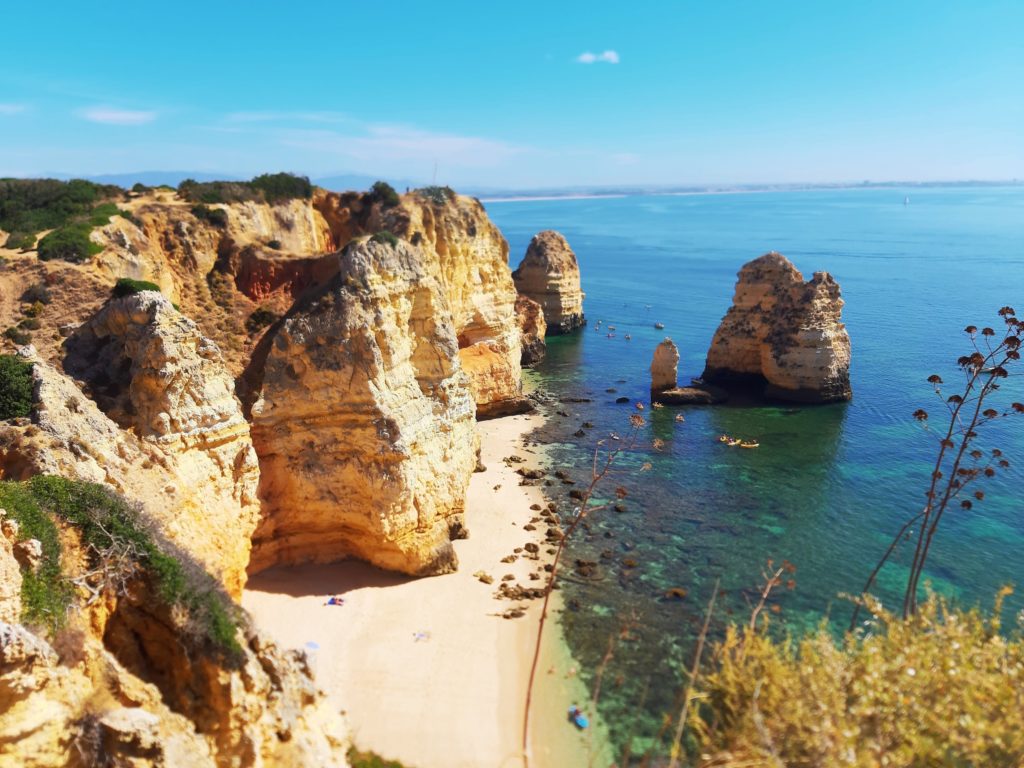
Photo by Reiseuhu / Unsplash
Jon Silva, a young activist in the south of Portugal, wrote to us with this issue:
The coastal area in Lagos, Portugal called Ponta da Piedade is used by the community as a place to enjoy nature and exercise during the COVID-19 pandemic. But it is void of any proper facilities or infrastructure, and the area has only one restaurant which has a monopolistic license. Meanwhile the remaining part of the land has been fenced off by construction companies, who are speculating on it and whose interests are being defended by local government.
This was clearly a local issue (Lagos is a town of 30,000), and we thought a campaign could make progress on it in four weeks. And we found the idea of a beauty spot fenced off by private interests intriguing and compelling.
Jon told us his Ultimate Goal was to:
Open the area for the community and create proper facilities and licenses for other businesses to better serve the people . We could prepare a project plan and present to the municipality. We could get together so the community benefits from the natural area, instead of a few private businesses.
Jon was seeking to improve his town, and already had a picture of how it could look. We dug deeper.
2. Researching the issue
Through two Zoom calls with Jon, we learned more about him and the issue.
We learned that the Ponta Da Piedade cliffs were a national treasure, which gave the story considerable PR value. Jon told us many influential residents lived near the cliffs, or had holiday houses in Lagos.
The problem was that the municipality had blocked access to the cliffs, erecting fences on the public part of the land. They hadn’t published the development plans, so the community didn’t know what was going on.
Jon had grown up in Lagos, so he was directly affected2. He had an engaging personal story: he had returned from work abroad, got sick with COVID, and now wanted to support his community. And he had a base of contacts across the area who wanted to help.
Although the campaign was in its infancy, Jon had assembled a small group of residents to help him with it. He was preparing for the long term — he planned to set up an association to have weight with the municipality, and contribute to the sustainable development of Lagos.

Fencing around the Ponta Da Piedade cliffs. Source: Jon Silva
This was obviously an issue we could support a campaign on, and Jon was the right person to run it. But before we could think about tactics3, we needed to narrow our focus. To concentrate on the part we could win.
3. Simplifying and focusing the campaign goals
We cut down the issue to the following:
The cliffs of Ponta da Piedade in Algarve, Portugal are one of the region’s best known natural attractions. But now, a large part of this land, both public and private, has been fenced off by private interests who are seeking to develop it. This would destroy the beauty of Ponta da Piedade, and block access to public visitors.
The campaign’s Ultimate Goal became:
The public parts of the Ponta Da Piedade cliffs are freely accessible to all. The local community helps decide what happens with the land in Ponta Da Piedade that is being targeted by private interests.
While Jon had originally wanted to work on the area’s sustainable development, we focused on the fact that private interests were targeting the land around the cliffs and, via the municipality, were blocking access to the public. We also added Jon’s idea to call for a public consultation, so the community can help decide what happens with the land.
This simplified the issue to a smaller number of actors, since the municipality was the ultimate decider who could tear down the fences, stop development, and hold a public consultation. The municipality thus became the target of the campaign. And ‘private interests versus nature for all’ was a simple, powerful message.
Lastly, we broke down the Ultimate Goal into individual objectives. Or, to see it another way, the campaign’s three demands:
We ask that the municipality:
- Removes the fences to ensure safe access to the cliffs
- Withdraws any current development plans for the cliffs, or related construction permits
- Holds a public consultation so the community can decide with the municipality how the area could best be used or developed.
4. Defining a headline to get our demands heard
How could reach these objectives in four weeks? How could we get the municipality to pay attention to our demands?
As mentioned, the municipality of Lagos was now the sole target of the campaign. So what are its pressure points? Well,
- its public image, and
- the desire to keep its constituents happy.
And as mentioned, Lagos is a holiday destination, with many wealthy and influential citizens living in the area.
So feeding all this into a brainstorm, we came up with a headline we thought the mayor would notice:
“Leading citizens of Lagos appeal to mayor to save the Ponta de Piedade cliffs from private interests”
Our tactics became about creating that headline. We’d get as many local, influential people as possible to sign an open letter calling for our demands. We’d deliver the letter to the municipality on a specified date, with a (COVID-safe) on-the-ground action. And we’d make a buzz about it all in the media that the mayor’s constituents are most likely to read… thus putting pressure on the mayor to react.
5. Generating the headline
Here are the tactics we implemented to make this headline a reality:

A drone video, showing the natural beauty of the ground and what’s at stake
We needed something that told the story of the campaign in less than a minute. Jon and our team found great drone footage on YouTube of the Ponta Da Piedade cliffs. He asked the creators if we could use their footage and give them credit, and most said yes. Jon also went to the cliffs and took his own footage of the parts that were fenced off.
We stitched this material together into a 54-second video with a short script and some background music. The result was this:
An open letter with our demands, easy for people to sign
Jon created a form on the site of his association, using a simple content management system from Mozello. He added the campaign demands, and embedded the drone video on the page so people could see quickly what the campaign was about.
The form needed to be as easy as possible for people to sign, so the it asked the bare minimum: name and email address. It also asked people for their occupation, so we could use this later in our PR material. And to ensure that the signatures were genuine, we asked them for the number of one of their identity documents. Lastly, we gave people the chance to include an optional message, so we could collect quotes.
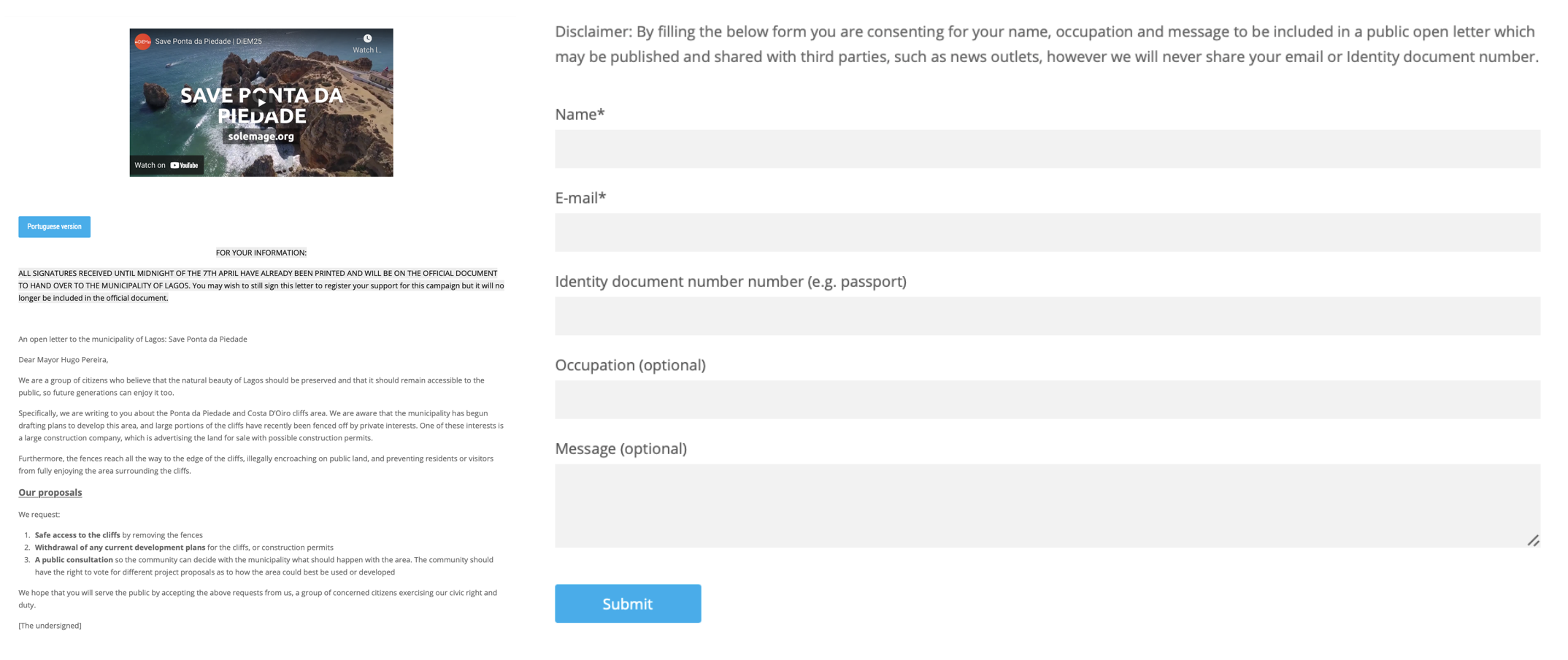
We promoted the open letter through social media, via the Facebook page of Jon’s association and DiEM25’s network. Jon and two of our team (Nadia Sales and Davide Castro, fortunately both Portuguese speakers) identified influential people that lived near the cliffs or valued them (e.g. people who had posted on social media about it). The team reached out to these targets directly, often via their social media profiles, asking if they would sign the open letter.
Parallel PR activities, to keep up interest
To maintain the campaign’s PR momentum and provide more material for it, we interviewed Jon for the DiEM25 website.
DiEM25 interviews Jon about the campaign
We also published an article on the campaign for the site, and translated all this material into Portuguese.
Meanwhile, Jon kept up interest by posting content on the Facebook page of his association. He took quotes that people had put in the form, turned them into graphics, and published them.

Some of the quote graphics that Jon created and posted on the Facebook page of his association. We got these quotes via the form on the open letter, which optionally offered people to submit a comment as they signed.
We reached out internally to the DiEM25 network in Portugal, telling our members there about the campaign and asking them to sign the letter. If we didn’t get influentials, we thought, at least we could get a large number of signatures as a backup.
Handover event: delivering the open letter the mayor, and generating PR around it
We set April 8 as the date for our ‘handover event’ — when Jon would go to Lagos Town Hall and hand over a printed copy of the open letter to the mayor. We wrote a press release, and Nadia pitched it to local, regional and national media, offering them interviews with Jon and inviting them to the action.
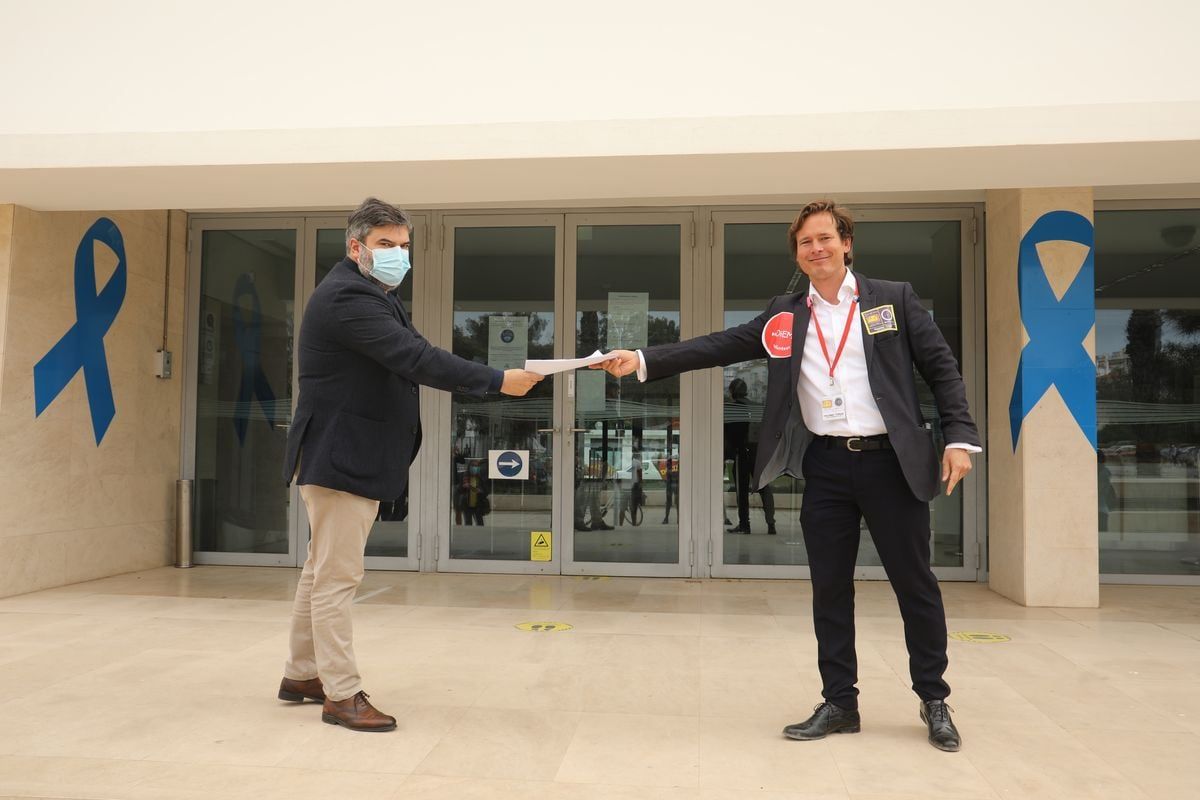
Jon hands over our open letter to the mayor of Lagos outside the town hall on April 8, 2021. Photo: Correio De Lagos
We also invited local DiEM25 members to the event, and planned a ‘stunt’ with them — a fake press conference. We asked people to bring cameras and microphones, and pretend to be interviewing Jon the steps of the town hall. The goal was to get photos and footage that we could then publish and pitch to journalists — with a wink! — to give the impression of intense media interest around saving the cliffs of Ponta Da Piedade.
6. So what happened?
Roughly half of our objectives were met
Here’s the all-important table:
| Objective | Met? | Comments |
| The municipality removes the fences to ensure safe access to the cliffs. | Almost met. At the handover event, the mayor revealed that he would remove the fencing in the public area of the cliffs. He didn’t provide a date for when it would happen, but assured that it was in process. | The campaign now has a public commitment on which to continue pressuring the mayor, and make sure the fences are removed. |
| The municipality withdraws any current development plans for the cliffs, or construction permits. | Half-met. As a result of the campaign, the mayor published the current plans for the land on the municipality’s website. The planned showed that the municipality intended to create boardwalks on the areas around the cliffs. Some minimal private development was also planned. | While this doesn’t amount to stopping development, it made a previously opaque process transparent. The public learned was that the plans to develop their area were not as damaging as they’d feared. |
| The municipality announces a date for a public consultation, so the community can decide with the municipality what should happen with the area. | Not (yet) met. | The mayor was not open to this. Jon will continue to push for it as he runs the rest of the campaign. |
Our tactics yielded good results
The outputs of our tactics were as follows:
- 500+ people signed our open letter, including Portuguese celebrities like the actress Rita Blanco and the singer Dino D’Santiago, both of whom gave us quotes that we included in the press release. Most other signatories were living in Lagos; the list included lawyers, business executives, investors, teachers and university professors, dentists, psychologists, sociologists, architects, researchers, environmental engineers, agronomists and even retired members of Lagos Council. 68 of these people gave us quotes, a selection of which we included in the press release.
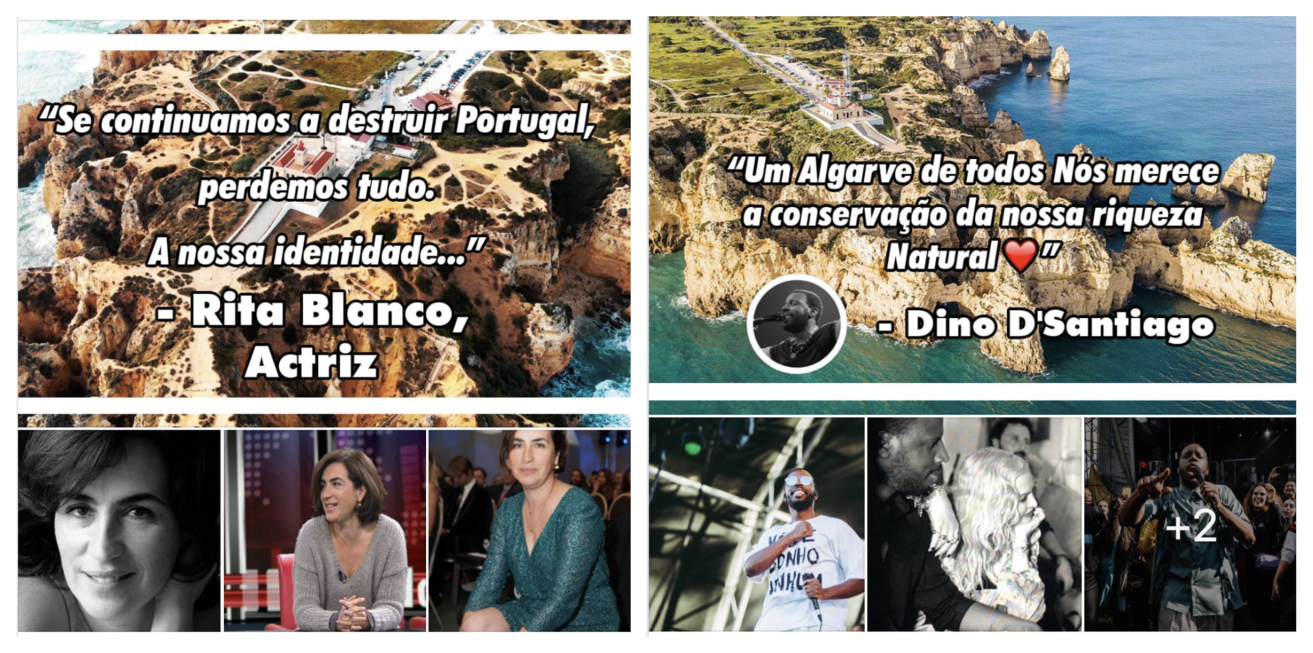
- We generated 20 pieces of positive coverage in regional media, and two in national media. The regional hits were significant, because these outlets were most likely to speak to the mayor’s constituents, and thus this coverage put more pressure on the mayor. Most coverage used the all-important headline of our press release (“Leading citizens of Lagos appeal to mayor to save the Ponta de Piedade cliffs from private interests”), and mentioned DiEM25’s role in the campaign. We were covered in Notícias ao minuto, TSF radio, Sul Informação (x2), Postal, Jornal do Algarve (x2), Algarve Primeiro, Barlavento, Região Sul, Mais Algarve, A Voz do Algarve, Correio de Lagos , CM Lagos , MoveAveiro (French), Algarve Daily News (English) (x2), Expatica (English) and Portugal Resident (English).
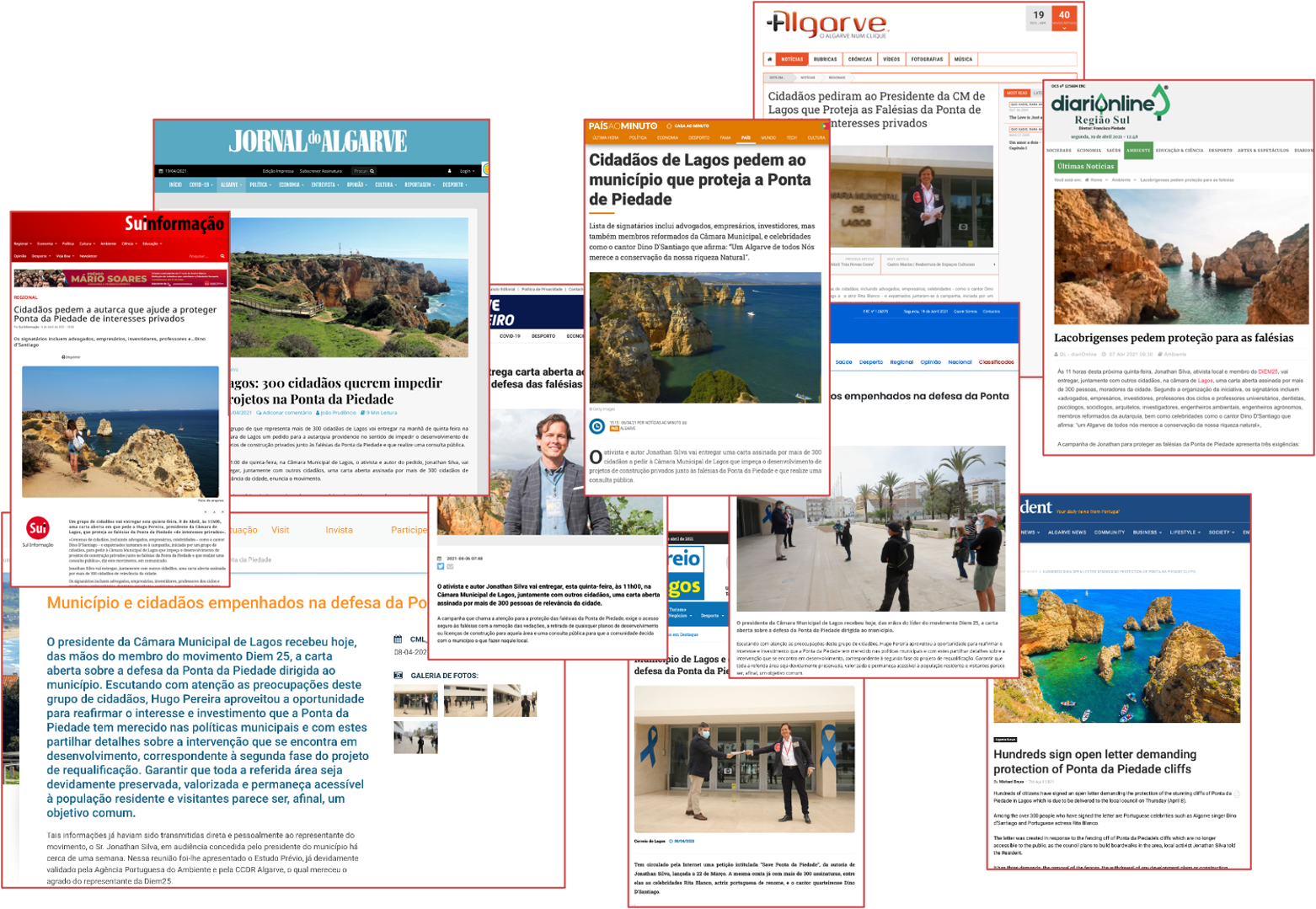
Some of the coverage we got for the campaign.
- Most articles included the angle of an active citizen — Jon — doing something for his community. We made this element dominant in the press release, and Jon gave four interviews in which he elaborated on it.
- A week before our handover event, the mayor invited Jon to a meeting. Here the municipality gave the campaign a preliminary response, indicating that the mayor was open to removing the fences. We were able to update the press release to cite this as an early victory of the campaign, which helped it generate traction.
- The mayor of Lagos attended our handover event, and was photographed with Jon. In fact, the municipality took the event so seriously that they made their own press release on it. From our side, 15 people attended the handover event. No media attended.
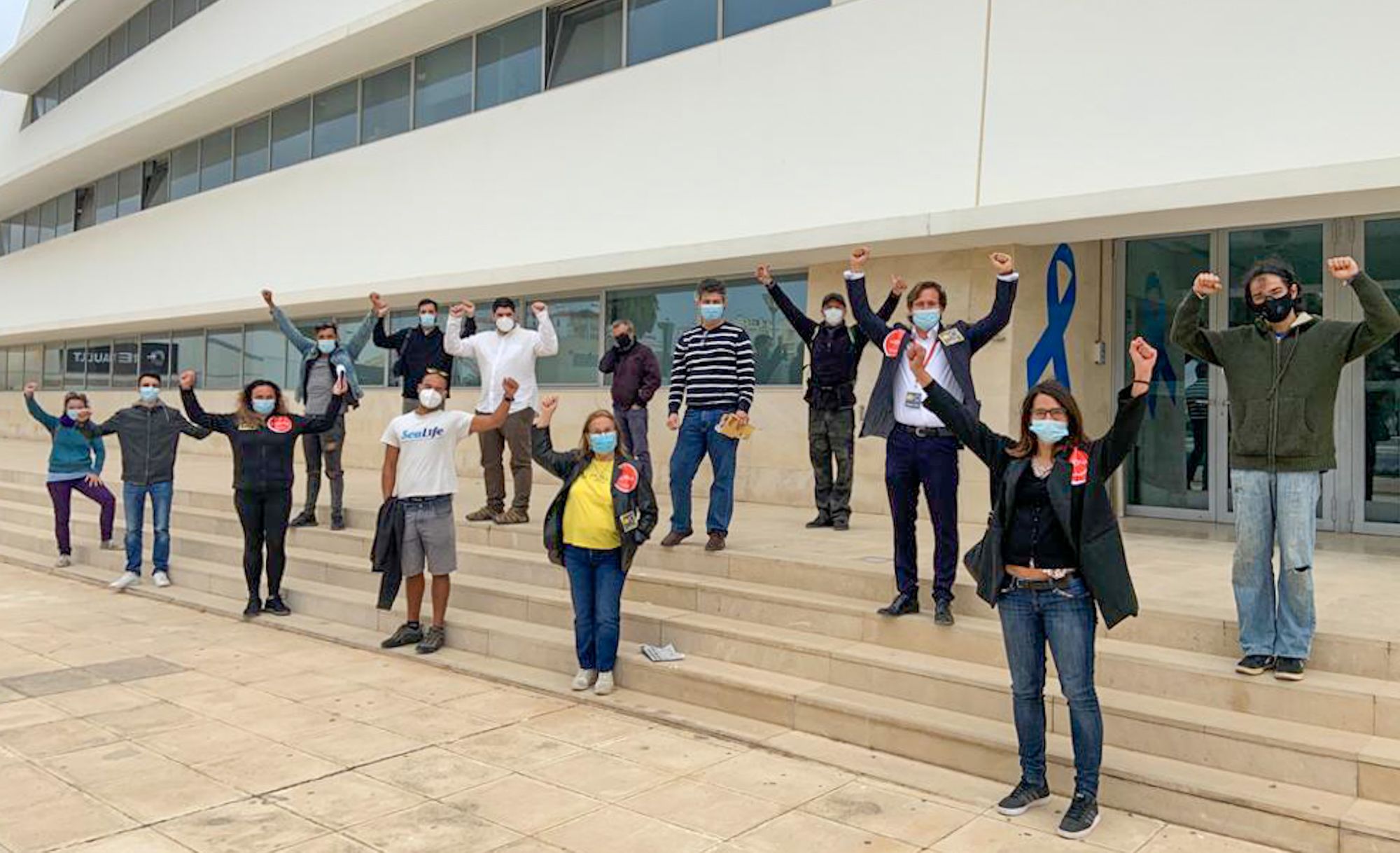
Our handover event outside the Lagos town hall on April 7, 2021. Photo: Nadia Sales
- We raised the profile of DiEM25. This will help drive membership of the movement in Portugal, and associates it with grassroots actions that make a difference.
- We positioned Jon in the media as an example that local activism can have an impact. Hopefully this will stimulate this kind of activism more generally.
- We generated a lot of material — quotes and media coverage but also photography and video — that Jon’s campaign (or others) can use to push for the sustainable development of the area.
- Organisationally, the campaign is in good shape for the future. It has a plan to work from (some of its demands are still unmet), a mailing list with hundreds of supporters, and credibility in the community and with the municipality. Furthermore, it also has legal support: a group of lawyers heard about the campaign and reached out to offer their services, free of charge.
7. Our assessment of the campaign
What worked and why?
The relative success of this campaign was down to this: the plan made sense, and Jon and the team executed it well.
The fact that Jon lived in the area, and was able to coordinate things on the ground, was important. This meant he could build a connection with the municipality, and hand over the open letter in person. It also helped that Jon had the time and means to see his campaign through. (But this was not critical to its success. With the right organisation, anyone could have followed the steps in our plan and got a result — they might just take longer to get there.)
On our side, we were fortunate that two of our team members (Nadia and Davide) knew the area and spoke the language. It was valuable that Nadia was able to travel to Lagos in person, to interview Jon and attend our handover event. And her contacts and pitching skills gave us a head start.
The success of the open letter was down to this targeted pitching, as well as the short drone video ‘advertising’ the campaign, and our efforts to reduce the friction for people to sign the letter by making the form as simple as possible.
Lastly (even if it sounds obvious), the running of the campaign was simplified by the fact that we:
- agreed our goals upfront
- ensured that our tactics were always in service of those goals, and
- worked to generate a headline rather than just doing stuff and hoping it lands.
This simplicity also made sure the team was always working to the same end.
What didn’t work and why?
- Our open letter didn’t get high numbers of signatures. With the open letter, our plan was to go for ‘quality’ (i.e. influentials, the ‘leading’ citizens of the headline we were aiming for). But quantity would have helped too, and 500+ signatures was nothing to shout about. We called out for signatures from DiEM25’s network, but didn’t get the numbers. Perhaps this was because DiEM25 is a pan-European movement, and local, grassroots activism like the Ponta Da Piedade story isn’t what people (yet) associate with it. Furthermore, the movement doesn’t have much presence in Portugal.
- Our handover event could have been better attended. As mentioned, were were able to get 15 people to show up to the handover event. This number isn’t bad for an activist event in a town the size of Lagos, and it didn’t really affect the results of the campaign. But still, planning for a larger crowd wasted our resources. And having 15 people present meant our ‘stunt’ idea of a fake press conference didn’t really work, so we didn’t get the images we wanted out of it. Why didn’t more people show? Probably because of the lack of DiEM25 members in Portugal, and our consequent inability to reach people there. COVID and bad weather didn’t help.
- We got zero international media coverage. We were aiming for local coverage with this campaign, because that’s what the mayor’s constituents were most likely to read. But it would have been valuable to have international coverage, too, in case the campaign wanted to set its activities in a wider context later on. And because wealthy foreigners have holidays houses in Lagos, and the campaign might want to target them in future. We failed on this because of internal organisation, and because we didn’t pitch properly.
8. Closing thoughts
We had an impact with this campaign. It reached roughly half its goals: it pushed the mayor to remove the fencing the public area of the cliffs, allowing people to enjoy their natural beauty once more. And the campaign compelled him to reveal the development plans for the area.
We did get lucky — the planned developments were not as bad as feared, so the headline we aimed for (‘Save Ponta Da Piedade’) even became hyperbolic. But we forced transparency on the issue, and set a precedent for the area of Lagos in case developers get tempted to plan hotels or resorts that damage the landscape.
With the campaign, we created a template for future actions. Anyone seeking to protect beauty spots from private interests can tweak these tactics and learn from our experience. We promoted DiEM25 in a country where it still has a low presence, and helped connect the movement to successful local activism.
We’ve also verified once again that the Campaign Accelerator programme works. It helps grassroots activists generate impact, and promotes rigorous, results-oriented activism that has world-changing potential.
Jon’s campaign continues. And for us — the next Campaign Accelerator cycle starts later this year.
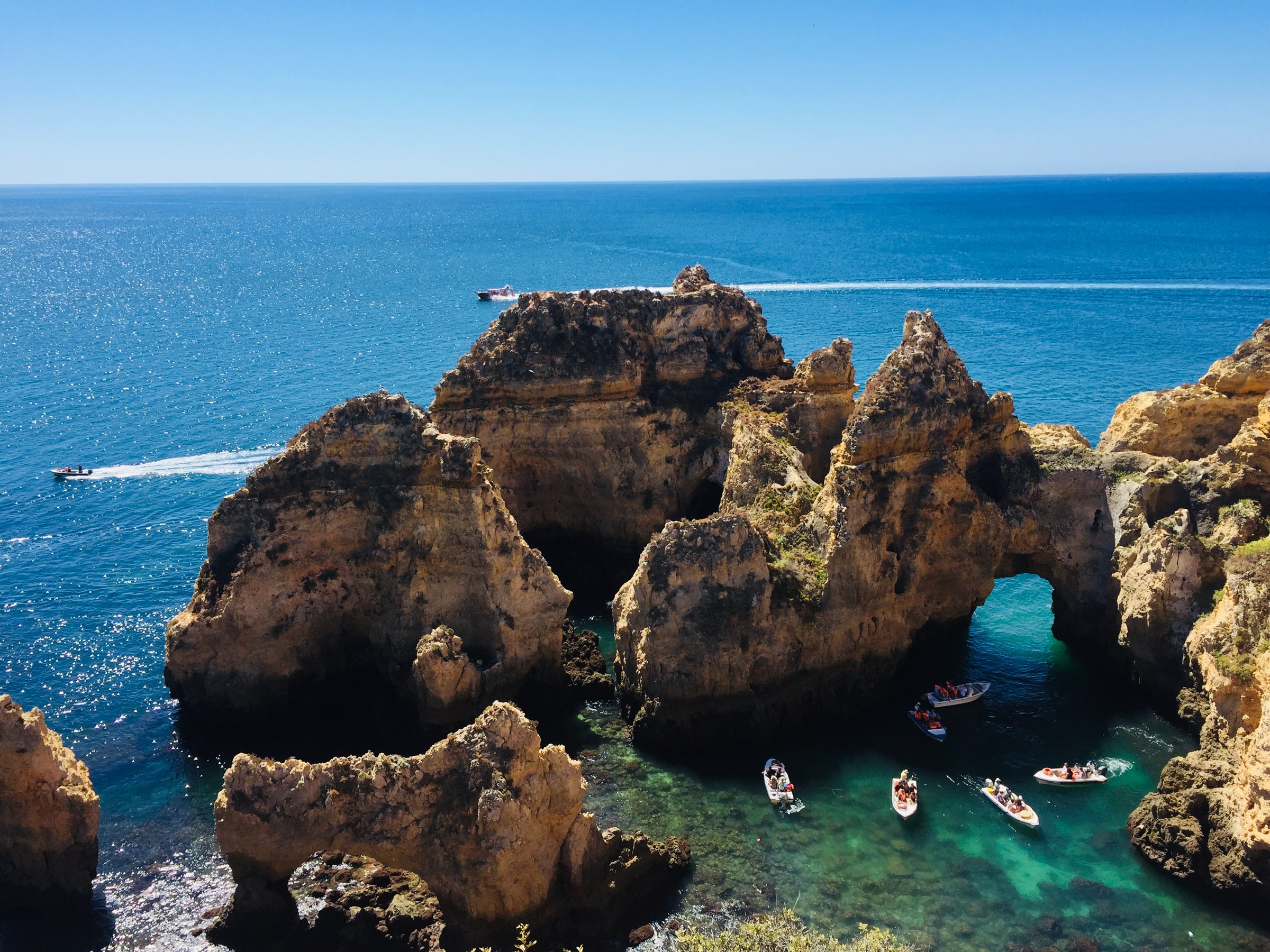
Photo by Cristiano Pinto / Unsplash
Footnotes
1: Campaign Accelerator is a programme we developed to support targeted, local, grassroots campaigns by individual activists. People apply to have their proposals considered; the Campaign Accelerator team and I choose three applications which we think could have impact; and develop a plan for each. We then help the applicants execute their campaigns over four weeks. One of the three winning campaigns was the one cited in this post.
2: It’s hard to build an impactful campaign without involving people directly affected by the issue. So the fact that the Jon was affected and was on the ground, immediately gave this campaign an advantage.
3: In a recent activism workshop I attended, Nadine Bloch of Beautiful Trouble said of tactics “[They’re] those sexy things that make everyone interested in doing something. But they do actually need to deliver on your big vision.” Activists often rush into a campaign with a list of tactics, ignoring their Ultimate Goal and the preparatory work that should precede it. But doing this means your campaign becomes tactics-led. It can lose its way and become a scattergun campaign. Or one that generates a lot of noise and no impact.
Do you want to be informed of DiEM25's actions? Sign up here






